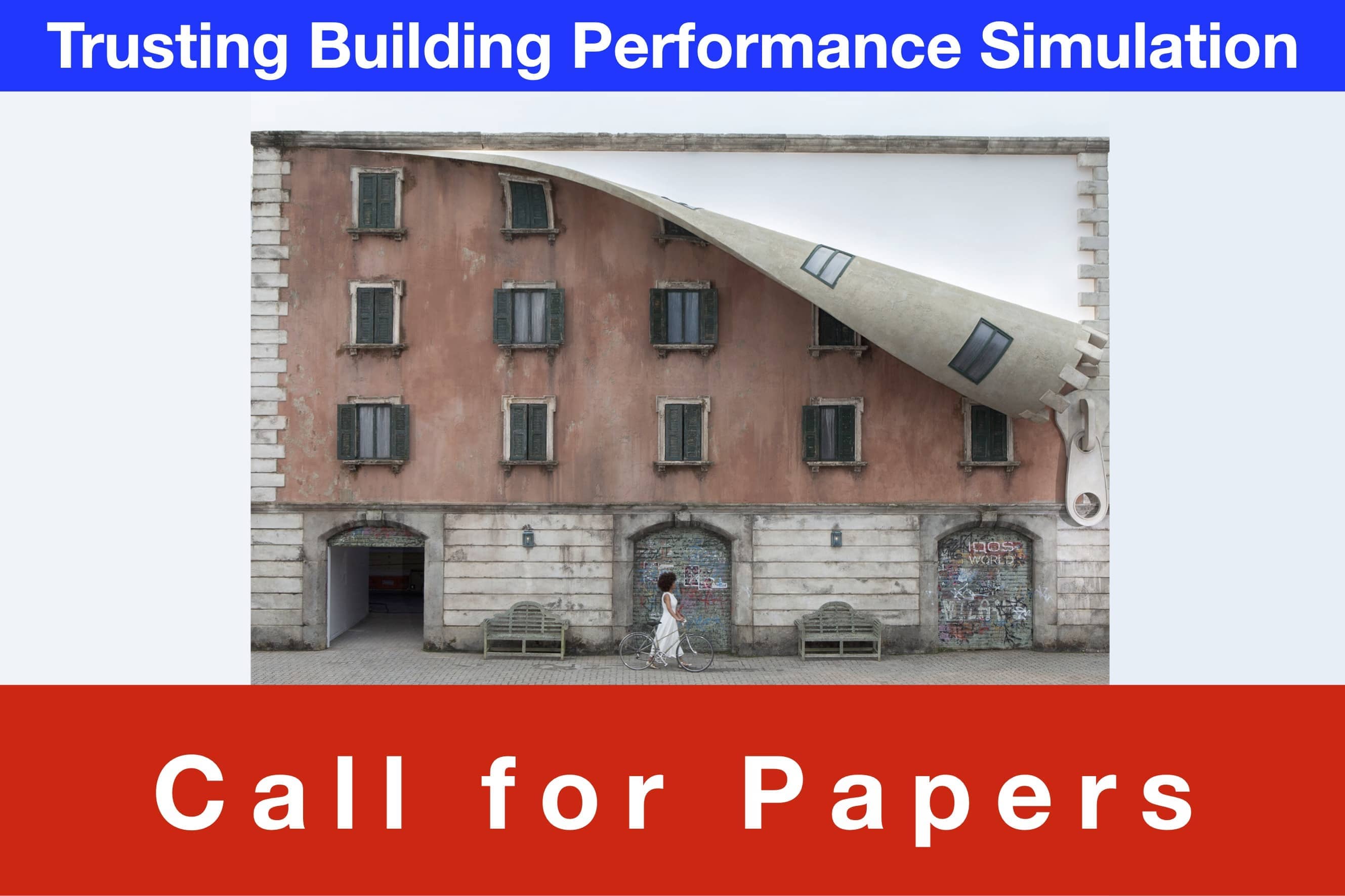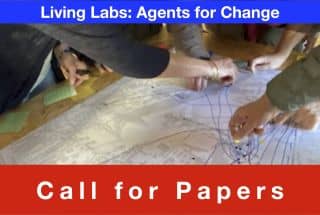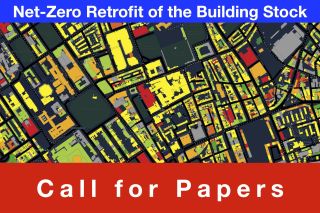
www.buildingsandcities.org/calls-for-papers/trusting-building-performance-simulation.html
Trusting Building Performance Simulation

Guest editor: Michael Donn (Te Herenga Waka-Victoria University of Wellington)
28 October 2024 (noon GMT)
Abstract submission closed on 11 November 2024 (noon GMT)
As codes and regulations become stricter, is simulation the right tool for compliance as well as sketching performance to assist design? Can building simulation address the competing demands and tensions that regulators, clients and designers place on it? If not, what alternatives could be appropriate?
This special issue seeks research reporting on quality assurance measures, case studies, user studies that address the development of trust in the performance calculations of designers. Papers are sought that describe the challenges, innovative methodologies, or strategies to enhance reliability and effectiveness. Overall, the papers should show evidence of improvement in guiding sustainable building practices. The "performance gap" typically references energy performance. However, this special issue is open to all design assessment parameters: Indoor Air Flows, Daylight, Energy, Overheating and Acoustics.
An increasing urgency exists to provide a prediction of performance over the next 50-100 years. As carbon limits become more fixed on absolute performance, a consensus is needed on how to examine performance reliably and accurately - both for new buildings as well as interventions in existing buildings. Uncertainties need to be made explicit.
Background
A broad literature and body knowledge already describes the gap between calculated and measured environmental performance of buildings. Papers in this field explore various hypothesised reasons for the gap. Suggestions include: need for improved modelling of building occupants (Ahn et al. 2017); and simulation users' lack of understanding of the drivers of performance (Imam et al. 2017). The latter concluded that modellers "cannot be considered modelling literate". A 2024 review paper identifies 173 relevant references (Zheng et al. 2024). Another paper looking at the performance gap in one Danish building contains 68 references (Carpino et al. 2020).
All essentially ask: "can we yet trust the tools we use in design"? All assume that our simplistic mid-20th century heuristics are no longer fit for purpose as they provide insufficient data for the quality goals we now set for our buildings. Performance measures such as static Heat Loss calculations in Energy and Daylight Factor in Lighting are one-dimensional in a multi-dimensional world.
However, with over two decades of publications, there is still no consensus on the solution. A decade ago, Coakley et al. (2014) examined 129 papers in an effort to identify a reliable process for "matching building energy simulation to measured data" and found current practice wanting. They identify the potential for a single annual energy use figure to be arrived at in a sophisticated simulation model by multiple combinations of input parameters. Proposers of surrogate modelling which emulates a complex (simulation) model using a statistical model (Westermann and Evans 2019) argue theirs is a more reliable approach to the single annual energy figure. Its reports can also be provided with an uncertainty figure, so design decisions can be more aware of the risks on non-performance. However, these same modellers do note that at present the ability of simulation to look in detail at performance, predicting overheating risk and so on cannot at present be matched by surrogacy.
Challenges
Architects are increasingly wanting to sketch performance in the same manner that they sketch a building concept (Braasch 2016). Architects and Engineers require sophisticated and complementary, but most likely not the same design decision performance estimation tools that do more than just report a single number (Bleil de Souza and Tucker 2015).
Is the answer better education in the "art" of simulation? Or, do we need to get much better at incorporating the variability of human behaviour in our buildings during design? Do we yet have a repository of trusted local material data on acoustic, lighting, energy properties of building elements and materials that could be used to make our design calculations to more closely resemble reality.
Imagine a window used for light and natural ventilation: can we source from one place the Visual Light Transmission for daylight analysis, the R-value and Solar Heat Gain coefficient for energy analysis; the acoustic properties of the window when it is opened or closed next to a busy street for ventilation, and so on. How well can we model the reliability and performance of equipment?
Others point to the differences between as-built and as-designed construction. And then, we have those who point to the inadequacies of our definitions of performance: are our 'comfort' standards fit for purpose? Is it appropriate to use simulation output: with its standardised inputs, as a 'prediction' of performance, or should it be treated like car sales brochure fuel-efficiency reports: as standardised index?
Possible topics
Topics of interest include but are not limited to:
- Sources of uncertainty in building simulation and their impact on trust.
- Simulation alternatives - instead of many interconnected equations representing the building physics, perhaps design informed by an empirical performance database - whether PoE, case studies, statistics.
- Understanding and avoiding abuses of simulation.
- Calibration, validation, and accuracy testing of BPS tools.
- Problems arising from mis-use or mis-interpretation of simulation outputs (and associated professional responsibilities).
- Integrating BPS with measured data to reduce performance gaps.
- Improving modeling of complex systems such as occupant behaviour - is this appropriate for regulatory purposes?
- Improving the quality of simulation reporting - ensuring its relevance to design decisions, and socio-technical issues in operation.
- Improving modeller literacy and questioning tool design - should the user have to understand the calculation algorithm limitations in order to be a certified simulation user?
- Role of simulation in design, commissioning, and operations.
- Implications for energy code compliance and carbon reduction goals.
- AI integration with simulation tools enabling systematic learning from past simulations informing the next design or the next simulatio.
- Compliance - the reliability and limitations of simulation for demonstrating regulatory compliance.
Timeline
| Deadline for abstract submission | 11 November 2014 noon (GMT) | |
| Full paper due | 10 February 2025 | NB: authors can submit sooner if they wish |
| Referees' comments to author | 30 April 2025 | |
| Revised version due (if required) | 30 June 2025 | |
| Publication | September 2025 | NB: papers are published as soon as they are accepted |
Briefing note for contributors
We welcome contributions from the research community as well as the building industry including engineers, architects, researchers, code officials, and software developers.
You are invited to submit an abstract for this special issue. Please send a 500 word (maximum) abstract to editor Richard Lorch by 11 November 2024 noon (GMT). Your submission must also include these 3 items:
- the corresponding author's and all co-author's names, institutional & departmental affiliations and contact details, email addresses
- the question(s) or topic(s) in this Call for Papers that the abstract and intended paper address
- the abstract (500 words maximum) defining the research question(s), scope, methods and results
Abstracts will be reviewed by the editors to ensure a varied, yet integrated selection of papers around the topic. Authors of accepted abstracts will be invited to submit a full paper (6000-7500 words), which undergoes a double-blind review process.
Buildings & Cities is an international, open access, double-blind peer-reviewed research journal. Its focus is the interactions between buildings, neighbourhoods and cities by understanding their supporting social, economic and environmental systems. More information can be found online: https://www.buildingsandcities.org & published papers are found here: https://journal-buildingscities.org
General guidance for authors can be found at https://www.buildingsandcities.org/pdf/Information-for-Authors.pdf
Open access and Article Processing Charge
Buildings & Cities is an open access journal and has an article processing charge (APC) of £1360 plus VAT. If you do not have institutional support, please contact the editor when submitting your abstract. We endeavour to assist those without funding.
Questions?
The Editors are happy to discuss ideas with potential authors. Please contact: Richard Lorch and Michael Donn
References
Ahn, K.-U., Kim, D.-W., Park, C.-S. & de Wilde, P. (2017). Predictability of occupant presence and performance gap in building energy simulation. Applied Energy, 208, 1639-1652. https://doi.org/10.1016/j.apenergy.2017.04.083
Braasch, E. (2016). The feasibility of 'Building Performance Sketching' within the building design process. Thesis submitted to Te Herenga Waka - Victoria University of Wellington. https://doi.org/10.26686/wgtn.17019899
Carpino, C., Loukou, E., Heiselberg, P. & Arcuri, N. (2020). Energy performance gap of a nearly zero energy building (nzeb) in Denmark: the influence of occupancy modelling. Building Research & Information, 48(8), 899-921. https://doi.org/10.1080/09613218.2019.1707639
Coakley, D., Raftery, P. & Keane, M. (2014). A r3view of methods to match building energy simulations models to measured data. Renewable and Sustainability Energy Reviews, 37, 123-141. https://doi.org/10.1016/j.rser.2014.05.007
Imam, S., Coley, D. A. & Walker, I. (2017). The building performance gap: Are modellers literate? Building Services Engineering Research and Technology, 38(3), 351-375. https://doi.org/10.1177/0143624416684641
Molina, G., Donn, M., Johnstone, M. L. & MacGregor, C. (2023). The feeling of comfort in residential settings I: a qualitative model. Buildings & Cities, 4(1). https://doi.org/10.5334/bc.322
Westermann, P. & Evins, R. (2019). Surrogate modelling for sustainable building design - a review. Energy and Buildings, 198, 170-186. https://doi.org/10.1016/j.enbuild.2019.05.057
Zheng, Z., Zhou, J., Jiaqin, Z., Yang, Y., Xu, F. & Liu, H. (2024). Review of the building energy performance gap from simulation and building lifecycle perspectives: magnitude, causes and solutions. Developments in the Built Environment, 17, 100345. https://doi.org/10.1016/j.dibe.2024.100345
Latest Peer-Reviewed Journal Content
Net zero retrofit of the building stock [editorial]
D Godoy-Shimizu & P Steadman
Co-learning in living labs: nurturing civic agency and resilience
A Belfield
The importance of multi-roles and code-switching in living labs
H Noller & A Tarik
Researchers’ shifting roles in living labs for knowledge co-production
C-C Dobre & G Faldi
Increasing civic resilience in urban living labs: city authorities’ roles
E Alatalo, M Laine & M Kyrönviita
Co-curation as civic practice in community engagement
Z Li, M Sunikka-Blank, R Purohit & F Samuel
Preserving buildings: emission reductions from circular economy strategies in Austria
N Alaux, V Kulmer, J Vogel & A Passer
Urban living labs: relationality between institutions and local circularity
P Palo, M Adelfio, J Lundin & E Brandão
Living labs: epistemic modelling, temporariness and land value
J Clossick, T Khonsari & U Steven
Co-creating interventions to prevent mosquito-borne disease transmission in hospitals
O Sloan Wood, E Lupenza, D M Agnello, J B Knudsen, M Msellem, K L Schiøler & F Saleh
Circularity at the neighbourhood scale: co-creative living lab lessons
J Honsa, A Versele, T Van de Kerckhove & C Piccardo
Positive energy districts and energy communities: how living labs create value
E Malakhatka, O Shafqat, A Sandoff & L Thuvander
Built environment governance and professionalism: the end of laissez-faire (again)
S Foxell
Co-creating justice in housing energy transitions through energy living labs
D Ricci, C Leiwakabessy, S van Wieringen, P de Koning & T Konstantinou
HVAC characterisation of existing Canadian buildings for decarbonisation retrofit identification
J Adebisi & J J McArthur
Simulation and the building performance gap [editorial]
M Donn
Developing criteria for effective building-sector commitments in nationally determined contributions
P Graham, K McFarlane & M Taheri
Reimagining circularity: actions for optimising the use of existing buildings
R Lundgren, R Kyrö, S Toivonen & L Tähtinen
Effective interdisciplinary stakeholder engagement in net zero building design
S Vakeva-Baird, F Tahmasebi, JJ Williams & D Mumovic
Metrics for building component disassembly potential: a practical framework
H Järvelä, A Lehto, T Pirilä & M Kuittinen
The unfitness of dwellings: why spatial and conceptual boundaries matter
E Nisonen, D Milián Bernal & S Pelsmakers
Environmental variables and air quality: implications for planning and public health
H Itzhak-Ben-Shalom, T Saroglou, V Multanen, A Vanunu, A Karnieli, D Katoshevski, N Davidovitch & I A Meir
Exploring diverse drivers behind hybrid heating solutions
S Kilpeläinen, S Pelsmakers, R Castaño-Rosa & M-S Miettinen
Urban rooms and the expanded ecology of urban living labs
E Akbil & C Butterworth
Living with extreme heat: perceptions and experiences
L King & C Demski
A systemic decision-making model for energy retrofits
C Schünemann, M Dshemuchadse & S Scherbaum
Modelling site-specific outdoor temperature for buildings in urban environments
K Cebrat, J Narożny, M Baborska-Narożny & M Smektała
Understanding shading through home-use experience, measurement and modelling
M Baborska-Narożny, K Bandurski, & M Grudzińska
Building performance simulation for sensemaking in architectural pedagogy
M Bohm
Beyond the building: governance challenges in social housing retrofit
H Charles
Heat stress in social housing districts: tree cover–built form interaction
C Lopez-Ordoñez, E Garcia-Nevado, H Coch & M Morganti
An observational analysis of shade-related pedestrian activity
M Levenson, D Pearlmutter & O Aleksandrowicz
Learning to sail a building: a people-first approach to retrofit
B Bordass, R Pender, K Steele & A Graham
Market transformations: gas conversion as a blueprint for net zero retrofit
A Gillich
Resistance against zero-emission neighbourhood infrastructuring: key lessons from Norway
T Berker & R Woods
Megatrends and weak signals shaping future real estate
S Toivonen
A strategic niche management framework to scale deep energy retrofits
T H King & M Jemtrud
Generative AI: reconfiguring supervision and doctoral research
P Boyd & D Harding
Exploring interactions between shading and view using visual difference prediction
S Wasilewski & M Andersen
How urban green infrastructure contributes to carbon neutrality [briefing note]
R Hautamäki, L Kulmala, M Ariluoma & L Järvi
Implementing and operating net zero buildings in South Africa
R Terblanche, C May & J Steward
Quantifying inter-dwelling air exchanges during fan pressurisation tests
D Glew, F Thomas, D Miles-Shenton & J Parker
Western Asian and Northern African residential building stocks: archetype analysis
S Akin, A Eghbali, C Nwagwu & E Hertwich
Join Our Community

The most important part of any journal is our people – readers, authors, reviewers, editorial board members and editors. You are cordially invited to join our community by joining our mailing list. We send out occasional emails about the journal – calls for papers, special issues, events and more.
We will not share your email with third parties. Read more



Latest Commentaries
Building-Related Research: New Context, New Challenges
Raymond J. Cole (University of British Columbia) reflects on the key challenges raised in the 34 commissioned essays for Buildings & Cities 5th anniversary. Not only are key research issues identified, but the consequences of changing contexts for conducting research and tailoring its influence on society are highlighted as key areas of action.
Lessons from Disaster Recovery: Build Better Before
Mary C. Comerio (University of California, Berkeley) explains why disaster recovery must begin well before a disaster occurs. The goal is to reduce the potential for damage beforehand by making housing delivery (e.g. capabilities and the physical, technical and institutional infrastructures) both more resilient and more capable of building back after disasters.